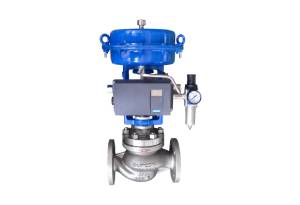May. 02, 2020
1. Globe control valve structure: it is composed of two parts: actuator and body parts. Valve accessories include filter pressure-reducing Valve, electrical Valve positioner, handwheel mechanism, Valve position switch, Valve position transmitter, air solenoid valve, etc. The actuator is the push device of the control valve, it produces the corresponding thrust according to the output signal, causes the pushrod to produce the corresponding displacement (a straight stroke or angular stroke displacement), thus drives the spool action of the control valve; The valve body part is the regulating part of the control valve, it is in direct contact with the medium, by the movement of the valve core to change the throttle area of the control valve to achieve the purpose of regulation.
Ii. Classification and action forms of actuators: they are divided into two categories: pneumatic actuators and electric actuators (both of which include direct stroke and angular stroke).Pneumatic actuators can be divided into pneumatic film actuators, pneumatic piston actuators (single action and double action cylinder). Because they do not use an electric actuator do not introduce temporarily. Pneumatic thin-film actuator can be divided into positive and reaction two forms when the signal pressure increases the push rod downward action is called positive action actuator when the signal pressure increases the push rod upward action is called reaction actuator. Pneumatic thin-film actuators usually receive gas signals of 20~100kPa, and there are also actuators with gas signals of 80~200kPa and 120~300kPa. The air supply pressure is generally 140kPa, 300kPa, and 340kPa, respectively. Pneumatic piston actuators usually use a 400kPa air source.

Single Seat Globe Control Valve
3. Classification according to the form of body parts: single seat globe control valve, eccentric rotating body (CAM flexion body), ball Valve body, butterfly Valve body, wedge gate Valve body, and tee Valve body. According to the original state of the valve can be divided into fault on (gas off), fault off (gas on) two forms.
4. Parameters characterizing the characteristics of the regulating valve: A, circulating capacity Cv value; B. Flow characteristics: EQ%, LINER, fast opening, parabola;C. Adjustable ratio R=Qmax/Qmin;D. pressure loss S; E. valve opening; F. Leakage quantity when the valve is fully closed; G. Full travel time.
The control valve used by the device includes pneumatic film control valve, eccentric rotating control valve, pneumatic tee cut-off valve, pneumatic wedge gate valve, pneumatic cut-off valve, self-operated control valve, solenoid valve.
Six, Pneumatic diaphragm regulating valves, through the single-seat regulating valve is a valve core and valve seat, wide application, has a small leakage (leakage of 0.01% C), using the differential small (DN100 Δ P = 120 kph), small flow capacity (DN100 C = 120), the characteristics of pneumatic diaphragm actuator has a simple structure, reliable action, easy maintenance, low cost, the characteristics of the valve core can be processed into a variety of flow characteristic in the form of membrane gas consumption is small.
Seven, Eccentric rotating control valve: on occasions of great viscosity, it is characterized by simple flow path, low resistance, large circulating capacity, reliable sealing, stable operation, small volume, and lightweight. Its flow characteristics are between linear and equal percentage, and the rotary stroke Angle is 60/90 degrees.
Headquarter Add.: SUPCON Park, No.309 Liuhe Road, Binjiang District, Hangzhou, 310053, China.
Tel.: +86 571 8111 9774
Fax: +86 571 8111 9737
E-mail: [email protected]
